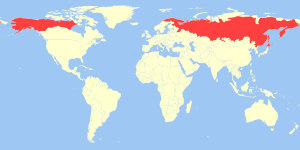Northern red-backed vole facts for kids
Quick facts for kids Northern red-backed vole |
|
|---|---|
 |
|
| Conservation status | |
| Scientific classification | |
| Genus: |
Myodes
|
| Species: |
rutilus
|
 |
|
| Geographic range | |
The northern red-backed vole (Myodes rutilus) is a small, slender vole. You can find these furry creatures in places like Alaska, northern Canada, Scandinavia, and northern Russia.
Contents
About the Northern Red-backed Vole
These voles have short, slim bodies. Their backs are a rust-red color, while their sides and undersides are light brown. They also have a short, thick tail. You can see their small ears poking through their fur.
A northern red-backed vole is usually about 14 centimeters (about 5.5 inches) long. Its tail adds another 3.5 centimeters (about 1.4 inches). They weigh around 30 to 40 grams, which is about the same as a few strawberries. These voles are active all year long, even in winter! They usually move around at night.
Where Northern Red-backed Voles Live
Northern red-backed voles make their homes in many northern forests and shrublands. They live in nearly every type of forest in central Alaska.
You might find them among trees like black spruce (Picea mariana) and white spruce (Picea glauca). They also live near quaking aspen (Populus tremuloides) and paper birch (Betula papyrifera). Other plants in their habitat include alder (Alnus spp.) and willow (Salix spp.).
They also live near smaller plants like mountain cranberry (Vaccinium vitis-idaea), blueberry, and bilberry (Vaccinium spp.). Bunchberry (Cornus canadensis) and various grasses and small plants are also common. Important fungi, mosses, and lichens are part of their world too. These include truffle (Endogone fascilulata), Schreber's moss (Pleurozium schreberi), and sphagnum (Sphagnum spp.).
Preferred Habitats
Northern red-backed voles are often found in areas with thick northern shrubs or open taiga forests. They also live in tundra regions. These voles can be found in new forest areas and in older, mature forests. Sometimes, they even live among rocks and on rocky slopes.
Voles use paths or "runways" through plants to travel. They build their nests in short burrows or under things like rocks or tree roots. They stay active all winter long, digging long tunnels under the snow. Their winter nests are usually on the ground, hidden in thick moss. Sometimes, they even sneak into houses during the winter!
Why Cover is Important
Northern red-backed voles choose places with lots of dense ground cover. This cover helps protect them from bad weather and from animals that might try to eat them. In Alaska, more voles were found where there was more protective cover.
During winter, they use thick moss or matted plants to stay warm. In one study in central Alaska, all the voles gathered in a small area of thick moss. This happened even though there was plenty of food in other places. This shows how important good cover is for them.
Life Cycle and Reproduction
The breeding season for northern red-backed voles usually runs from May to August. Female voles can have two or three litters (groups of babies) during this time. The first litter is born in late May or early June.
A litter can have four to nine babies, but the average is about six. Young voles can't control their body temperature well until they are about 18 days old. Around this time, they stop drinking their mother's milk and leave the nest. Young voles don't grow much during the winter because there isn't as much food.
When a young vole becomes old enough to have its own babies depends on when it was born. About 20% of females born in the first litter will breed in the same summer. The rest, and those born later, will breed the following May. If spring comes late, fewer young females might be ready to breed that year. In places where there are many voles, young females might wait longer to breed or move to a new area.
Northern red-backed voles are mostly active at night or during twilight (dawn and dusk). However, they will be active whenever they need to be, especially during the long daylight hours in the Arctic summer.
What Northern Red-backed Voles Eat
Northern red-backed voles eat many different things. They munch on leaves, buds, twigs, and berries from shrubs. They also eat small plants, fungi, mosses, lichens, and sometimes even insects.
Berries are usually a very important part of their diet. They eat them whenever they can find them. In central Alaska, studies showed that voles ate a lot of berries all year round. These included bog blueberry (Vaccinium uliginosum), mountain cranberry, black crowberry (Empetrum nigrum), and bunchberry.
Voles mainly eat berries in the fall and winter. They only eat lichens during the winter and spring. In early summer, when berries are not ready, they eat mosses. In mid-to-late summer, mosses are still a big part of their diet, but berries become their main food again.
On the Kenai National Wildlife Refuge, voles ate mountain cranberries and bunchberries in the summer. They also ate fungi, green plants, and insects. As fungi became more common later in the summer, they made up a large part of the voles' diet. This suggests that voles might prefer fungi over mountain cranberries.
Who Hunts Northern Red-backed Voles
Many animals hunt northern red-backed voles. Some of their predators include the American marten (Martes americana) and the Arctic fox (Alopex lagopus). The red fox (Vulpes vulpes), raccoon (Procyon lotor), and stoat (Mustela erminea) also hunt them. Other predators are the snowy owl (Bubo scandiacus) and the coyote (Canis latrans). Most other animals that hunt small mammals in the vole's habitat probably eat them too.
In Alaska, northern red-backed voles and other types of voles made up a big part of the American marten's diet. They were 74% of what martens ate in the summer and 68% in the winter.
Images for kids



